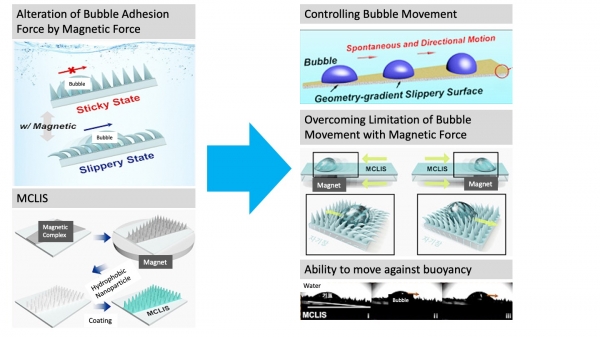
Water must be decomposed into oxygen and hydrogen gas to obtain hydrogen energy. This water decomposition reaction proceeds differently depending on the movement of bubbles in water. The research team lead by Professor Yong Kijung (CE) and Han Kiduk (CE Ph.D. Integrated Candidate, advisor Prof. Yong Kijung) has developed a technology on surface materials that freely controls the movement of bubbles in water decomposition to produce hydrogen energy. The new technology can adjust the movement of bubbles both horizontally and vertically, and overcome the limited movement of bubbles that was restricted in small areas.
Adjusting the movement of bubbles in water is an important technique in various applications such as hydrogen production, gas separation, heat transfer, material transfer, and optical fluids. So far, several methods such as asymmetric surface treatment techniques have been developed to control the movement of bubbles in water. But these methods have limits in application because the bubbles tend to move from large to narrow areas and are trapped in small areas.
To overcome the limitations, the research team used microwires that respond to magnetic forces. Magnetic microwires were embedded on the surface and coated with lubricant. The embedded microwires were able to stand upright or lie horizontally on the surface depending on the applied magnetic field.
The wire had high surface adhesion force when upright and low adhesion force when lying on the surface. The research team succeeded in moving bubbles in both directions by controlling the shape of microwires with magnetic force and adjusting adhesion force. They also confirmed the possibility of moving bubbles in the direction opposite to buoyancy. Furthermore, they developed microreactors to induce chemical reactions in water, and demonstrated their application as optical laser shutters.
Prof. Yong said, “It is a new intelligent surface technology that freely controls the movement of droplets in water. It can be used to produce hydrogen energy through water decomposition because it can move droplets in the desired direction.”
The study was introduced in Advanced Functional Materials on April 17. It was supported by the National Research Foundation of Korea.


